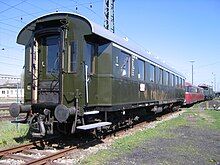Karwendel (train)
| Stops | Halle (Saale), Jena Paradies, Nuremberg, Munich |
|---|---|
| Train number(s) | ICE 1206/1207 |
| Line(s) used | Karwendelbahn |
| Technical | |
| Rolling stock |
|
| Track gauge | 1,435 mm (4 ft 8+1⁄2 in) |
| Electrification | 15 kV AC |
The Karwendel is an international named express train service between Germany and Austria. The train was named after the
History

Since the opening of the Mittenwald Railway line in 1912, train service was provided to reach the tourist resorts in the Karwendel range such as
After the war, D-Zug service continued from Munich to Seefeld and Innsbruck. In 1969 the Deutsche Bundesbahn reintroduced the Ft Karwendel train using VT 11.5 TEE diesel multiple units.[1] The Saturday only train was classified as package tour touristtrain serving several wintersport resorts along the Karwendelbahn between Garmisch and Seefeld. The service started in Frankfurt am Main, much farther north then the pre-war start at Munich.[2] From the introduction of the Intercity system in 1971 the train was named ICt Karwendel.[3]

In May 1979 a daily Intercity service from Bremen to Innsbruck named IC Karwendel has been introduced,[3] hauled by DB Class 103 and 111 electric locomotives. On 31 May 1987 it was one of the initial EuroCity services.[4] The EuroCity started as far north as Hamburg but its initial southern terminus Innsbruck was already changed to Seefeld by September 1987 and after only one year as EuroCity the train was reconverted into an Intercity.[5]
Since 2008 the Karwendel has been an
In July 2017, the Murnau Mayor Rolf Beuting was informed that the railway is planning the hiring of the ICE train pair Munich-Innsbruck. Only two train pairs from the Ruhr area and Hamburg-Berlin to Garmisch-Partenkirchen are to remain. The Karwendel would then lose its long-distance train in Mittenwald and Seefeld. The Deutsche Bahn states as justification that the train is uneconomical because of decreasing numbers of passengers. In addition, he did not fit into the vehicle revolutions after the opening of the Erfurt-Nuremberg High Speed Railway. The passengers from the north benefited from the 1/2 hours shorter travel time. The mayors of the Bavarian and Tyrolean neighboring communities protest against the decision. They fear that holiday guests, for whom a connection without change is important, will avoid the Karwendel area in the future. According to the mayor, around 25 to 25% of guests currently travel to Mittenwald by train. The service is restored in December 2018.
References
- ^ Reisen 1.Klasse page 93
- ^ Timetables of FDt Karwendel 1969 and 1970 at www.welt-der-modelleisenbahn.com
- ^ a b Timetables of IC Karwendel from 1971 to 1984 at www.welt-der-modelleisenbahn.com
- ^ Deutsche Bahn, timetable Ihr Zugbegleiter 1987, shown at www.grahnert.de
- ^ "EuroCity-Net Gewijzigd". De Kampioen (in Dutch). The Royal Dutch Touring Club (ANWB): 61. July–August 1988. Retrieved 26 March 2013.
- ^ Current DB-timetable, kursbuch.bahn.de, table (Kursbuchstreckennummer) 960
Works cited
- Berndt, Torsten (2002). Reisen 1. Klasse VT 11.5 (in German). Irsee: Märklin.
